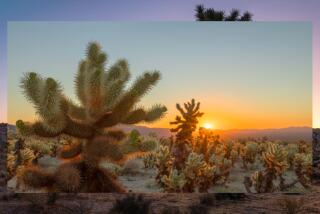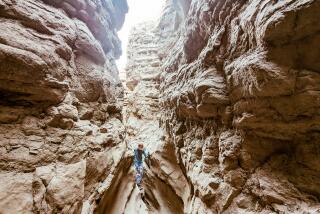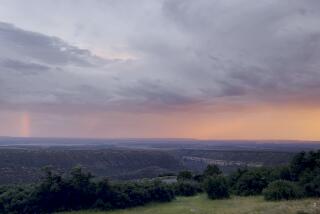Climb Pikes Peak for Famous View of a Stunning America the Beautiful
COLORADO SPRINGS, Colo. — No doubt you know that it bears the best-known name of any mountain in the country.
What you probably don’t know, unless you’ve made the spectacular, winding trip to the top, is that the snow-capped massif called Pikes Peak also offers the most famous vista to be seen from any American mountain.
Looking eastward from the summit of Pikes Peak, 14,110 feet above sea level, you see an endless expanse of spacious skies stretching over amber waves of grain.
When you turn around and gaze west, you see purple mountain majesties above the fruited plain. And as you look over this scenic splendor, you know for certain that you have found America the beautiful.
If those descriptive phrases sound familiar, they should. For it was here on the summit of Pikes Peak, in the Front Range of the Colorado Rockies just 20 miles west of Colorado Springs, that a Wellesley College professor named Katharine Lee Bates was moved to write the poem that has become the national anthem of our nation’s physical grandeur: “America the Beautiful.”
Much has changed about America since the July day in 1893 when Bates traveled to the summit and was instantly inspired to create her moving hymn. Happily, though, the view from atop Pikes Peak has not changed much at all.
All the wonders that sent Bates scrambling for pen and paper are still here to see. The rolling waves of grain fields to the east still glisten a deep amber beneath a mid-summer sun. And the imposing mountain majesties off to the west--ridge after ridge of snowcapped ranges--really do look purple against the dark blue Rocky Mountain sky.
Thus if you’re searching for a travel destination that will prove--either to yourself or to your kids--that this country is still America the beautiful, you can’t go wrong by planning a trip to southern Colorado and a trek to the top of Pikes Peak.
There were three ways to get to the top of the Peak when Bates made the trip: by foot, by train and by carriage. The same three ways are available today, except that the horse-drawn carriage that took Bates and her party up the Pikes Peak Highway has been replaced by the family car.
Unless you choose to hike, the trip today is quick and relatively easy. A round trip on the Cog Railway that chugs up the mountain’s east face takes three hours and 10 minutes, including a little less than an hour at the top.
Driving the steep, winding 20-mile highway takes about an hour each way. Which means you will probably spend just half a day visiting America’s most famous mountain.
Even if it hadn’t been lucky enough to be given a memorably alliterative name, Pikes Peak would almost certainly have become a famous natural feature. This is a simple fact of geography.
Pikes Peak is the easternmost of the “fourteeners”--the elite category of American mountains reaching higher than 14,000 feet. As such, it was the first to be “discovered” when the white man began exploring the mountain west nearly two centuries ago.
A U.S. Army lieutenant, Zebulon Montgomery Pike, was dispatched in 1806 to head an exploratory troop mapping the lower reaches of the Louisiana Purchase--sort of a southern version of the Lewis and Clark expedition.
Following the Arkansas River west from the Mississippi, Pike and his men spent week after redundant week traversing the empty flatlands of the high plains.
Then, on Nov. 16, 1806, on an eastern Colorado meadow about 120 miles from the present city of Colorado Springs, Pike looked up to the west and saw “a small blue cloud.”
As they came closer, the soldiers gradually realized that this spot on the sky was really a massive, snow-draped mountain. Thanks to the prerogatives of rank, the peak was eventually named for the commanding officer of the troop that found it.
That enormous mountain marks an abrupt shift in the topography of the continent. Here the flat, featureless meadowland of middle America gives way to the wrinkled spine of Rocky Mountains that make up the Continental Divide.
And the change occurs with dramatic suddenness. With just a few low foothills before it, Pikes Peak juts up abruptly from the plains to scratch the sky.
Consequently, the nation’s easternmost alp quickly became a powerful symbol of the rugged West--”the most celebrated peak in America,” as the Forest Service puts it.
When the gold seekers of 1859 set out from Kansas City, their wagons were emblazoned with the famous slogan, “Pikes Peak or Bust.”
Over time, railroad interests created a resort city, Colorado Springs, at the base of the mountain to help draw tourists. Hiking trails, the cog railroad and a narrow carriage road were constructed on the mountain to carry visitors to the peak of the Peak.
Thus it was only natural when Katharine Lee Bates arrived in the Springs to teach a summer school course at Colorado College--one of her faculty colleagues that summer of ’93 was a political scientist from Princeton named Woodrow Wilson--that she should set aside a day to travel to the summit.
When she alighted from her carriage at the top, Bates wrote later, she stood still for “an ecstatic moment” drinking in “the most glorious scenery I ever beheld.”
“As I was looking out over the sealike expanse of fertile country spreading away so far under those ample skies,” Bates recalled afterward, “the opening lines of the hymn floated into my mind . . . Oh beautiful for spacious skies, for amber waves of grain. . . .”
Today, Katharine Lee Bates (1859-1929) is well remembered in the environs of Pikes Peak. If you stop to visit the campus of Colorado College, a lovely green oasis near the heart of downtown Colorado Springs, you can see a mural honoring her poem in the school’s Shove Chapel.
And in the small gift shop/rest house at the top of the mountain, there’s an author’s holograph of “America the Beautiful” in Bates’s own hand.
If you’re traveling from the West to Pikes Peak, you’ll probably stop in Denver and then drive the 70 miles to Colorado Springs. If the sky is clear--a rare occurrence in Denver these days--you’ll see the Peak poking its snowy face skyward due south of Denver airport as your plane comes in to land.
Driving south along Interstate 25, you’ll begin to get marvelous vistas of the majestic mountain about 20 miles out of Denver. For my money, the view from the north is the most dramatic way to see Pikes Peak.
The great white mountain (it is snow-covered about 42 weeks of the year) hunkers there on the horizon like a great white whale, its long ridge rising gradually to the sharp peak.
Just north of Colorado Springs, I-25 skirts the campus of the U.S. Air Force Academy, nestled in against the jagged hills of the Rampart Range on the eastern slope of the Rockies. There’s a well-marked overlook here that offers a stunning view of the eastern face of the Peak, the face that Zebulon Pike first saw from his vantage point out on the plains.
When you reach Colorado Springs, it’s a 10-minute drive westward on Route 24 to the little tourist town of Manitou Springs, where most of the routes up Pikes Peak begin.
Intrepid hikers might choose to trek to the top on the Barr Trail, a well-marked but extremely demanding hiking route laid out by Fred Barr from 1914 to 1918.
According to the Forest Service, thousands of people start the trip every year and a few hundred finish it. It’s roughly 12 miles of hiking--no technical climbing required--with some incredibly steep sections and scores of switchbacks.
A lot of people turn back early, because the first four miles are quite tough, and down there below timberline there’s not much view of the peak. Those hikers who make it all the way generally plan on a two-day round trip, with a stopover at Barr Camp, four miles and 4,000 feet below the summit.
Among the regular hikers are the members of Colorado Springs’ Ad-Am-An (i.e., “add a man”) Club. This fraternal organization adds one member each year. The neophyte must pass initiation by climbing to the top on New Year’s Eve, when the club sets off an annual fireworks display that can be seen for 50 miles in all directions.
Manitou Springs is the boarding point for the Pikes Peak Cog Railway, an electric train with two bright red cars that follow a surprisingly straight track to the top. Round-trip fare is $17 for adults, $8 for people between 5 and 11 years old; preschoolers ride free.
The most popular means of ascent these days is the Pikes Peak Highway, a serpentine 20-mile toll road that is paved for the first seven miles and then becomes reasonably smooth gravel. This is a steep and occasionally terrifying driving experience, but most two-wheel-drive family cars can make it. It’s open from May to October each year.
At the toll gate, you’ll be charged $14 for a family of four. The rangers there offer driving tips: Don’t use your air conditioning; it will make hard-working engines overheat. Stop now and then on the way down to let your brakes cool off.
To enforce that last rule, there is frequently a policeman stationed about five miles below the summit to feel each car’s wheels and warn motorists whose brakes are overheated. The best time to go is in the morning, because the summit can be hazy or completely fogged in on summer afternoons.
The drive up Pikes Peak is one of the loveliest auto trips you can imagine, particularly above timberline (11,500 feet in Colorado), where the views seem to spread out forever and the mountainside becomes a vast white sea of snow.
And then you reach the summit, bundle up against the nippy summer breeze, throw snowballs until your hands freeze solid and soak in the 360-degree splendor of the mountain view that you’ve been singing about since your school days.
America! America! From this unequaled vantage point at the very roof of the Rockies, it is clear that God really has shed His grace on thee.
For more information on Pikes Peak, call the Colorado Springs Convention and Visitors Bureau at (800) 888-4748, Ext. 20 or 22.
More to Read
Sign up for The Wild
We’ll help you find the best places to hike, bike and run, as well as the perfect silent spots for meditation and yoga.
You may occasionally receive promotional content from the Los Angeles Times.






